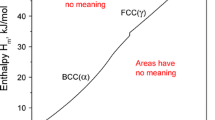Abstract
We present the application of a fast quasi-adiabatic continuous method to the measurement of specific heat at 4He temperatures, which can be used for the study of a wide range of materials. The technique can be performed in the same configuration used for the relaxation method, as the typical time constants between calorimetric cell and thermal sink at 4.2 K are chosen to be of the order of τ∼30 s. The accuracy in the absolute values have been tested by comparing them to relaxation-method results obtained in the same samples (performed in situ using the same set-up), with a deviation between the absolute values <3 % in the whole temperature range. This new version of the continuous calorimetric method at low temperatures allows us to completely characterize and measure a sample within a few hours with a high density of data points, whereas when employing other methods we typically need a few days. An exhaustive study has been performed for reproducibility to be tested. In the present work, we have applied this method to two different substances: CeSb2, which exhibits three magnetic transitions at 15.5 K, 11.7 K and 9.5 K, and graphite, both highly-oriented pyrolytic graphite (HOPG) and natural crystals. Our results on these graphites are discussed in comparison with previous published data on different kinds of graphite samples.








Similar content being viewed by others
References
F.J. Morin, J.P. Maita, Phys. Rev. 129, 3 (1963)
B.T. Matthias, T.H. Geballe, K. Andres, E. Corenzwit, G.W. Hull, J.P. Maita, Science 159, 530 (1968)
R.C. Zeller, R.O. Pohl, Phys. Rev. B 4, 6 (1971)
F. Pobell, Matter and Methods at Low Temperatures, 1st edn. (Springer, Berlin, 1992), pp. 30–43 and 64–77
E. Gmelin, Thermochim. Acta 29, 1 (1979)
T.H.K. Barron, G.K. White, Heat Capacity and Thermal Expansion at Low Temperatures (Kluwer Academic, New York, 1999). Chap. 3
P.F. Sullivan, G. Seidel, Phys. Rev. 173, 3 (1968)
R. Bachmann, F.J. DiSalvo Jr., T.H. Geballe, R.L. Greene, R.E. Howard, C.N. King, H.C. Kirsch, K.N. Lee, R.E. Schwall, H.U. Thomas, R.B. Zubeck, Rev. Sci. Instrum. 43, 205 (1972)
E. Pérez-Enciso, M.A. Ramos, Thermochim. Acta 461, 50 (2007)
T. Plackowski, Y. Wang, A. Junod, Rev. Sci. Instrum. 73, 2755 (2002)
F. Hullinger, H.R. Ott, J. Less-Common Met. 55, 103 (1977)
P.C. Canfield, J.D. Thompson, Z. Fisk, J. Appl. Phys. 70, 5992 (1991)
S.L. Bud’ko, P.C. Canfield, C.H. Mielke, A.H. Lacerda, Phys. Rev. B 57, 13624 (1998)
J. Liu, A.G. Rinzler, H. Dai, J.H. Hafner, R.K. Bradley, P.J. Boul, A. Lu, T. Iverson, K. Shelimov, C.B. Huffman, F. Rodriguez-Macias, Y.-S. Shon, T.R. Lee, D.T. Colbert, R.E. Smalley, Science 280, 1253 (1998)
D.S. Bethune, G. Meijer, W.C. Tang, H.J. Rosen, W.G. Golden, H. Seki, C.A. Brown, M.S. de Vries, Chem. Phys. Lett. 179, 181 (1991)
T.W. Ebbesen, P.M. Ajayan, Nature 358, 220 (1992)
K.S. Novoselov, A.K. Geim, S.V. Morozov, D. Jiang, Y. Zhang, S.V. Dubonos, I.V. Grigorieva, A.A. Firsov, Science 306, 666 (2004)
B.J.C. van der Hoeven Jr., P.H. Keesom, Phys. Rev. 130, 4 (1963)
U. Mizutani, T. Kondow, T.B. Massalski, Phys. Rev. B 17, 8 (1978)
M.A. Ramos, J. Barzola-Quiquia, P. Esquinazi, A. Muñoz-Martín, A. Climent-Font, M. García-Hernández, Phys. Rev. B 81, 214404 (2010), and references therein
P.C. Canfield, Z. Fisk, Philos. Mag. B 65, 1117 (1992)
A. Mandanici, M. Cutroni, A. Triolo, V. Rodriguez-Mora, M.A. Ramos, J. Chem. Phys. 125, 054514 (2006).
M. Hassaine, R.J. Jiménez-Riobóo, I.V. Sharapova, O.A. Korolyuk, A.I. Krivchikov, M.A. Ramos, J. Chem. Phys. 131, 174508 (2009)
Y. Wang, T. Plackowski, A. Junod, Physica C 355, 179 (2001)
M.G. Alexander, D.P. Goshorn, D.G. Onn, Phys. Rev. B 22, 4535 (1980)
J. Hone, B. Batlogg, Z. Benes, A.T. Johnson, J.E. Fisher, Science 289, 1730 (2000)
J. Hone, M.C. Llaguno, M.J. Biercuk, A.T. Johnson, B. Batlogg, Z. Benes, J.E. Fisher, Appl. Phys. A 74, 339 (2002)
M.I. Bagatskii, M.S. Barabashko, A.V. Dolbin, V.V. Sumarokov, B. Sundqvist, Low Temp. Phys./Fiz. Nizk. Temp. 38, 667 (2012)
Acknowledgements
The Laboratorio de Bajas Temperaturas (LBT-UAM) is an associated unit with the ICMM-CSIC. This work was partially supported by the Spanish MINECO (FIS2011-23488, and Consolider Ingenio Molecular Nanoscience CSD2007-00010 program) and by the Comunidad de Madrid through program Nanobiomagnet (S2009/MAT-1726). T.P.-C. acknowledges financial support from the Spanish Ministry of Education through FPU grant AP2008-00030 for a PhD thesis. J.H. acknowledges financial support from the Spanish Ministry of Education through grant SB2010-0113 for a postdoctoral stay. We are grateful to Daniel Farías for providing us with the sample of natural graphite, and to Paul Canfield for his stay at our Laboratory where he led the implementation of an experimental set-up for growing metallic crystals at high temperatures, within our MSc program on Condensed Matter Physics and Nanotechnology. The CeSb2 crystal was grown by us using that system.
Author information
Authors and Affiliations
Corresponding author
Rights and permissions
About this article
Cite this article
Pérez-Castañeda, T., Azpeitia, J., Hanko, J. et al. Low-Temperature Specific Heat of Graphite and CeSb2: Validation of a Quasi-adiabatic Continuous Method. J Low Temp Phys 173, 4–20 (2013). https://doi.org/10.1007/s10909-013-0884-8
Received:
Accepted:
Published:
Issue Date:
DOI: https://doi.org/10.1007/s10909-013-0884-8




